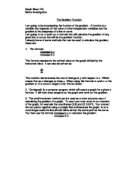Joseph Fitzpatrick, 11C
Year 11 Graphical Maths project
The aim of this project is to be able to create a system for understanding the relationship between the gradients of tangents of curves. Unlike straight lines, curves cannot have a single gradient that applies to the whole curve, but there are an infinite number of straight lines that can touch the curve at one point. There is only one perfect tangent line for each point on a curve, and all of these tangent lines have different gradients. It is the relationship between these gradients that will be explored in the first part of this investigation.

This is a preview of the whole essay
Peer Reviews
Here's what a star student thought of this essay
Quality of writing
In the conclusion of the first part, it is stated "the lines either do not touch at all or continue to touch at more than one point despite how much zooming is done". It is not clear if this statement is meant to express an error in the method or a new discovery in mathematics. The level of language and usage of technical vocabulary is fine however the conclusions from the investigations is quite unclear.
Level of analysis
The essay is presented in an acceptable manner, however the analysis is very shallow and on the surface. Well-presented and understood as deep as it goes but it does not go deep enough to make the topic clear to the reader. This topic is a very in-depth topic in Mathematics and algebra which extends all the way to calculus however the depth of analysis here is really not enough to explore the topic.
Response to question
The author uses a reasonable method to approach the problem and is successful in answering the proposed question to a certain extent, however the answer is rather specific than general as is the question. Short sentences and obvious facts are helpful in introducing the problem to less technical individuals.







